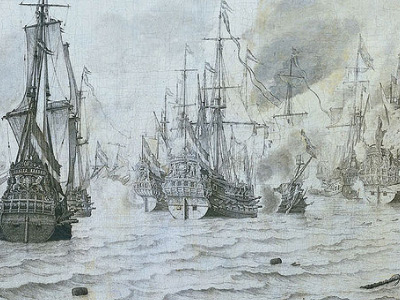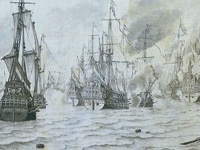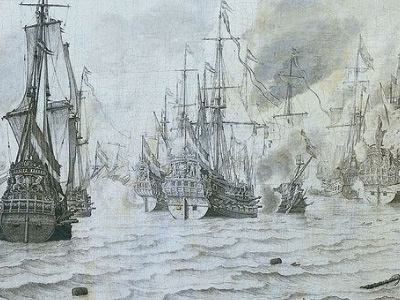Eighty Years' War (1568–1648)

First Forty Years (1566–1609)
Philip gave full power to the Duke of Alba in 1567. Alba's judgment was that of a soldier trained in Spanish discipline and piety. His object was to crush the rebels without mercy on the basis that every concession strengthens the opposition. Alba hand-picked an army of 10,000 men. He issued them the finest in armor while attending to their baser needs by hiring 2,000 prostitutes. Alba installed himself as Governor General and appointed a Council of Troubles which the terrified Protestants renamed "The Council of Blood." There were nine members: seven Dutch and two Spanish. Only the two Spanish members had the power to vote, with Alba personally retaining the right of final decision on any case that interested him. Through a network of spies and informers, hardly a family in Flanders did not mourn some member arrested or killed. One morning, 1,500 wee seized in their sleep and sent to jail. There were short trails held, often on the spot, for 40 or 50 at a time. In January, 1568, 84 people were executed from Valenciennes alone. William of Orange decided to strike back at Spain, having organized three armies. He lost every battle and the Eighty Years War was underway.
Two new forces emerged to oppose Spain The Spanish Empire was a colonial empire governed by Spain and its predecessor states between 1492 and 1976. One of the largest empires in history, it was the first to usher the European Age of Discovery and achieve a global scale, controlling vast territory. It was one of the most powerful empires of the early modern period, reaching its maximum extent in the 18th century.. Seizing upon the term, Beggars, used earlier in a derogatory manner by Margaret of Parma, the Dutch rebels formed the Wild Beggars and the Beggars of the Sea. The Wild Beggars pillaged churches and monasteries, cutting off the noses and ears of priests and monks. The Beggars of the Sea took to pirating under commission from William of Orange. William, who raised another army after a series of earlier defeats, again battled the Spanish without a single victory. He could neither control his troops nor deal with the fanatic Beggars. There existed no true unity between Catholics, Calvinists, and Protestants against Alba. The Beggars, who were nearly all ardent Calvinists, showed against the Catholics the same ferocity that the Inquisition and the Council of Blood had shown against rebels and heretics. Their captives were often given a choice between Calvinism and death. They unhesitatingly killed those who clung to the old faith, sometimes after incredible tortures. One Protestant historian wrote:
The Spanish Empire was a colonial empire governed by Spain and its predecessor states between 1492 and 1976. One of the largest empires in history, it was the first to usher the European Age of Discovery and achieve a global scale, controlling vast territory. It was one of the most powerful empires of the early modern period, reaching its maximum extent in the 18th century.. Seizing upon the term, Beggars, used earlier in a derogatory manner by Margaret of Parma, the Dutch rebels formed the Wild Beggars and the Beggars of the Sea. The Wild Beggars pillaged churches and monasteries, cutting off the noses and ears of priests and monks. The Beggars of the Sea took to pirating under commission from William of Orange. William, who raised another army after a series of earlier defeats, again battled the Spanish without a single victory. He could neither control his troops nor deal with the fanatic Beggars. There existed no true unity between Catholics, Calvinists, and Protestants against Alba. The Beggars, who were nearly all ardent Calvinists, showed against the Catholics the same ferocity that the Inquisition and the Council of Blood had shown against rebels and heretics. Their captives were often given a choice between Calvinism and death. They unhesitatingly killed those who clung to the old faith, sometimes after incredible tortures. One Protestant historian wrote:
On more than one occasion men were seen hanging their own brothers, who had been taken prisoners in the enemy rank. The islanders found fierce pleasure in these acts of cruelty. A Spaniard had ceased to be human in their eyes. On one occasion a surgeon at Veer cut the heart from a Spanish prisoner, nailed it on a vessel's prow, and invited the townsmen to come and fasten their teeth in it, which many did with savage satisfaction.
While Alba rested, he sent his son Don Fadrique to revenge the Beggar's atrocities. Don Fadrique's troops indiscriminately sacked homes, monasteries and churches. They stole the jewels and costly robes of the religious. They trampled consecrated hosts, butchered men and violated women. No distinction was made between Catholic or Protestant. His army crushed the weak defenses of Zutphen and put nearly every man in town to death, hanging some by the feet while drowning 500 others. Sometime later after brief resistance, Little Naarden surrendered to the Spaniards. They greeted the victorious soldiers with tables set with feasts. The soldiers ate, drank, then killed every person in the town. Don Fadrique's army later attempted to besiege Alkmaar but the rebels won by opening the dikes and routing the Spanish troops. When Don Fadrique came to Haarlem a brutal battle ensued. Haarlem was a Calvinist center that was known for its enthusiastic support of the rebels. A garrison of 4,000 troops defended the city with such intensity that Don Fadrique contemplated withdrawing. His father, Alba, threatened to disown him if he stopped the siege, so the barbarities intensified. Each army hung captives on crosses facing the enemy. The Dutch defenders taunted the Spanish besiegers by staging parodies of Catholic rituals on the cities ramparts.
William sent 3,000 men in an effort to relieve Haarlem. They were destroyed and subsequent efforts to save the city were futile. After seven months, when the city's inhabitants had been reduced to eating weeds and heather, the city surrendered (July 11, 1573). Most of the 1,600 surviving defenders were put to death and 400 leading citizens were executed. Those that were spared were shown mercy only because they agreed to pay a fine of 250,000 guilders, a sizable sum even by today's standards. This was considered the last and most costly victory of Alba's regime. The Bishop of Namur estimated that in seven years, Alba had done more to harm Catholicism than Luther or Calvin had done in a generation. A new Governor of the Netherlands followed.
The city of Maastricht was besieged on March 12, 1579. The Spanish attackers tunneled an extensive network of passages in order to enter the city beneath its walled defenses. The defenders dug tunnels to meet them. Battles were fought fiercely in underground caverns with limited maneuvering capabilities. Hundreds of besiegers were scalded or choked to death when boiling water was poured into the tunnels or fires were lit to fill them with smoke. In an attempt to mine the city, 500 Spanish soldiers were killed when the explosives detonated prematurely. It took more than four months but the besiegers finally breached the wall and entered the city at night. Catching the exhausted defenders sleeping, they massacred 6,000 men, women and children. Of the city's 30,000 population, only 400 survived.
Maastricht was a major disaster for the Protestant cause and the Dutch began to turn on William of Orange. After several unsuccessful attempts, William was assassinated in 1584 and died penniless. Spain had taken the upper hand on land but the Beggars still controlled the sea. Queen Elizabeth of England The Kingdom of England was a sovereign state on the island of Great Britain from about 927, when it emerged from various Anglo-Saxon kingdoms, until 1 May 1707, when it united with Scotland to form the Kingdom of Great Britain. The Viking invasions of the 9th century upset the balance of power between the English kingdoms, and native Anglo-Saxon life in general. The English lands were unified in the 10th century in a reconquest completed by King Æthelstan in 927. began to aid the Northern provinces and sent troops there in 1585. The Spanish Armada suffered defeat at the hands of the English in 1588 and the situation in the Netherlands
The Kingdom of England was a sovereign state on the island of Great Britain from about 927, when it emerged from various Anglo-Saxon kingdoms, until 1 May 1707, when it united with Scotland to form the Kingdom of Great Britain. The Viking invasions of the 9th century upset the balance of power between the English kingdoms, and native Anglo-Saxon life in general. The English lands were unified in the 10th century in a reconquest completed by King Æthelstan in 927. began to aid the Northern provinces and sent troops there in 1585. The Spanish Armada suffered defeat at the hands of the English in 1588 and the situation in the Netherlands The Dutch Republic was a confederation that existed from 1579, during the Dutch Revolt, to 1795. It was a predecessor state of the Netherlands and the first fully independent Dutch nation state. Although the state was small and contained only around 1.5 million inhabitants, it controlled a worldwide network of seafaring trade routes. The income from this trade allowed the Dutch Republic to compete militarily against much larger countries. It amassed a huge fleet of 2,000 ships, initially larger than the fleets of England and France combined. became increasingly difficult to manage.
The Dutch Republic was a confederation that existed from 1579, during the Dutch Revolt, to 1795. It was a predecessor state of the Netherlands and the first fully independent Dutch nation state. Although the state was small and contained only around 1.5 million inhabitants, it controlled a worldwide network of seafaring trade routes. The income from this trade allowed the Dutch Republic to compete militarily against much larger countries. It amassed a huge fleet of 2,000 ships, initially larger than the fleets of England and France combined. became increasingly difficult to manage.
HISTORY

RESOURCES
This article uses material from the Wikipedia article "Eighty Years' War (1568–1648)", which is released under the Creative Commons Attribution-Share-Alike License 3.0.
© Stories Preschool. All Rights Reserved.









